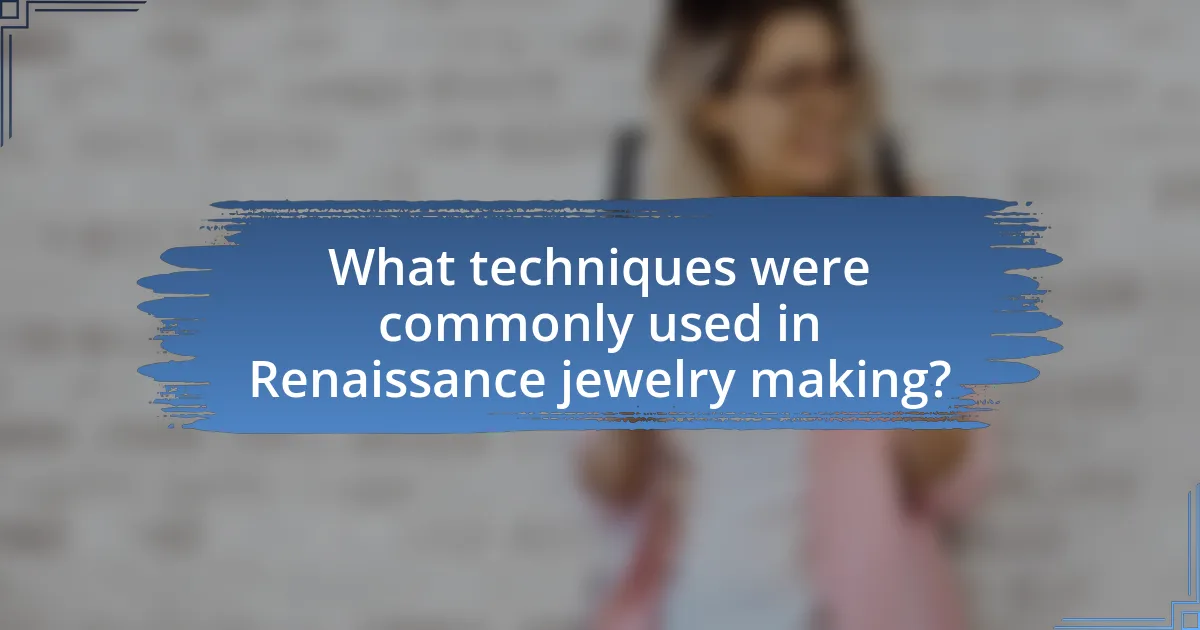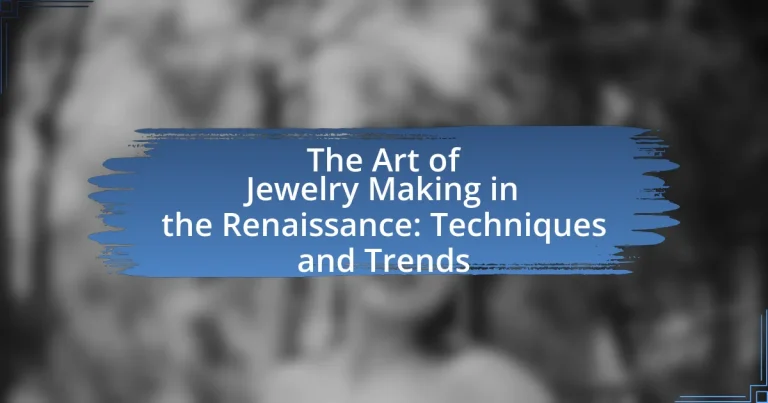The main entity of the article is the art of jewelry making during the Renaissance, characterized by intricate craftsmanship, the use of precious materials, and classical themes. The article explores the advanced techniques employed by jewelers, such as enameling, filigree, and gemstone setting, which enhanced the artistry of their creations. It also examines the cultural influences that shaped jewelry design, the role of the Church in promoting religious symbolism, and the impact of trade routes on material availability. Additionally, the article highlights key characteristics of Renaissance jewelry, including the choice of materials, evolving techniques, and the social implications of gemstone selection, while discussing trends influenced by fashion and portraiture.

What defines the art of jewelry making in the Renaissance?
The art of jewelry making in the Renaissance is defined by its intricate craftsmanship, use of precious materials, and incorporation of classical themes. Jewelers during this period employed advanced techniques such as enameling, filigree, and stone setting, which allowed for greater detail and artistry in their creations. The Renaissance also saw a revival of classical motifs, including mythological figures and natural elements, reflecting the era’s fascination with antiquity and humanism. Notably, the use of gemstones like diamonds, emeralds, and rubies became more prevalent, showcasing wealth and status. This period marked a significant evolution in jewelry design, emphasizing both aesthetic beauty and symbolic meaning.
How did cultural influences shape jewelry making during this period?
Cultural influences significantly shaped jewelry making during the Renaissance by integrating classical motifs, religious symbolism, and regional styles into designs. The revival of interest in ancient Greek and Roman art led artisans to adopt elements such as intricate filigree work and the use of gemstones, reflecting the era’s humanistic values. Additionally, the spread of trade routes facilitated the exchange of materials and techniques, allowing for the incorporation of exotic influences from the East, such as the use of enamel and intricate metalwork. This blending of styles resulted in unique pieces that not only served as adornments but also conveyed social status and personal identity, illustrating the profound impact of cultural dynamics on the art of jewelry making during this period.
What role did the Church play in the design and symbolism of jewelry?
The Church significantly influenced the design and symbolism of jewelry during the Renaissance by promoting religious themes and iconography. Jewelry often featured Christian symbols such as crosses, saints, and biblical scenes, reflecting the Church’s authority and the importance of faith in daily life. For instance, the use of gold and precious stones in ecclesiastical jewelry not only demonstrated wealth but also served as a testament to divine beauty and the glory of God. Additionally, the Church commissioned many pieces for liturgical purposes, ensuring that jewelry was imbued with spiritual significance and used in religious ceremonies. This close relationship between the Church and jewelry design established a lasting legacy that intertwined art, faith, and societal values during the Renaissance.
How did trade routes impact the availability of materials for jewelry making?
Trade routes significantly enhanced the availability of materials for jewelry making during the Renaissance by facilitating the exchange of precious metals and gemstones across regions. For instance, the Silk Road connected Europe to Asia, allowing access to exotic materials such as silk, pearls, and jade, which were highly sought after for jewelry. Additionally, maritime trade routes enabled the importation of gold and silver from the Americas and Africa, increasing the supply of these metals for artisans. Historical records indicate that cities like Venice and Florence became major centers for jewelry production due to their strategic locations along these trade routes, which provided a steady influx of diverse materials essential for intricate jewelry designs.
What were the key characteristics of Renaissance jewelry design?
Renaissance jewelry design was characterized by intricate craftsmanship, the use of precious materials, and a focus on naturalistic themes. Jewelers during this period employed techniques such as enameling, filigree, and gem setting to create elaborate pieces that often featured motifs inspired by nature, mythology, and religious symbolism. The incorporation of gemstones like diamonds, emeralds, and rubies was prevalent, reflecting the wealth and status of the wearer. Additionally, the revival of classical forms and the influence of humanism led to designs that emphasized beauty and proportion, aligning with the broader artistic trends of the Renaissance.
What materials were predominantly used in Renaissance jewelry?
Gold and silver were predominantly used in Renaissance jewelry. These metals were favored for their malleability, luster, and ability to be intricately crafted into elaborate designs. Additionally, gemstones such as diamonds, rubies, emeralds, and pearls were commonly incorporated, enhancing the aesthetic appeal and value of the pieces. Historical records indicate that the use of these materials reflected the wealth and status of the wearer, as well as the artistic trends of the period, which emphasized opulence and detailed craftsmanship.
How did techniques evolve during the Renaissance period?
Techniques in jewelry making evolved significantly during the Renaissance period through the introduction of new materials, methods, and artistic influences. Jewelers began to incorporate techniques such as enameling, which allowed for vibrant colors and intricate designs, and the use of goldsmithing techniques that enhanced the structural integrity and aesthetic appeal of pieces. The revival of classical motifs and the influence of humanism led to more naturalistic designs, as seen in the detailed craftsmanship of pieces like cameos and intaglios. Additionally, advancements in tools, such as the use of the bow drill and improved soldering methods, facilitated greater precision and complexity in jewelry design. These developments reflect a broader cultural shift towards individual expression and artistry during the Renaissance, marking a departure from the more utilitarian approaches of the Middle Ages.

What techniques were commonly used in Renaissance jewelry making?
Renaissance jewelry making commonly utilized techniques such as enameling, filigree, and gem setting. Enameling involved fusing powdered glass to metal, creating vibrant colors and intricate designs, which was a hallmark of Renaissance aesthetics. Filigree, characterized by delicate metalwork, involved twisting and soldering fine threads of gold or silver to form intricate patterns. Gem setting techniques included bezel and prong settings, which securely held precious stones in place while enhancing their visual appeal. These methods reflect the period’s emphasis on artistry and craftsmanship, as evidenced by surviving pieces that showcase these techniques.
How did goldsmithing techniques contribute to jewelry craftsmanship?
Goldsmithing techniques significantly enhanced jewelry craftsmanship by introducing advanced methods for shaping and detailing precious metals. These techniques, such as granulation, filigree, and enameling, allowed artisans to create intricate designs and textures that elevated the aesthetic appeal of jewelry. Historical evidence shows that during the Renaissance, goldsmiths in Europe developed these skills, leading to a flourishing of artistic expression in jewelry, as seen in the works of renowned goldsmiths like Benvenuto Cellini, whose creations exemplified the mastery of these techniques.
What are the differences between chasing and repoussé techniques?
Chasing and repoussé are two distinct metalworking techniques used in jewelry making. Chasing involves the use of tools to create designs by pushing the metal surface from the front, resulting in raised patterns or textures. In contrast, repoussé involves shaping the metal from the back, allowing for deeper relief and more pronounced forms. Historically, both techniques were prevalent during the Renaissance, with chasing often used for fine detailing and repoussé for creating more substantial, three-dimensional effects in metalwork.
How did engraving enhance the aesthetic appeal of jewelry?
Engraving enhanced the aesthetic appeal of jewelry by adding intricate designs and personalized details that elevated its visual complexity. This technique allowed artisans during the Renaissance to create unique patterns, motifs, and inscriptions, making each piece not only a decorative item but also a form of personal expression. Historical evidence shows that engraved jewelry often featured elaborate scenes or symbols that conveyed specific meanings, thus enriching the narrative quality of the pieces. For instance, the use of engraving in goldsmithing during the Renaissance led to the production of highly detailed brooches and pendants, which were sought after for their artistry and craftsmanship.
What role did gemstone setting play in jewelry making?
Gemstone setting was crucial in jewelry making during the Renaissance as it determined the aesthetic appeal and structural integrity of the pieces. This technique involved securely placing gemstones into metal settings, which not only showcased the stones’ brilliance but also enhanced the overall design of the jewelry. Historical records indicate that advancements in gemstone setting techniques, such as the use of prongs and bezels, allowed for more intricate designs and greater visibility of the stones, thereby elevating the craftsmanship and value of jewelry during this period.
What are the various methods of gemstone setting used in the Renaissance?
The various methods of gemstone setting used in the Renaissance include bezel setting, prong setting, and pavé setting. Bezel setting involves encasing the gemstone in a metal rim that holds it securely, providing a sleek and protective design. Prong setting uses metal claws to hold the gemstone in place, allowing more light to enter the stone and enhancing its brilliance. Pavé setting features small gemstones set closely together with minimal visibility of the metal, creating a continuous sparkle effect. These techniques reflect the Renaissance emphasis on artistry and craftsmanship in jewelry making, as evidenced by surviving pieces from the period that showcase these methods.
How did the choice of gemstones reflect social status and wealth?
The choice of gemstones during the Renaissance reflected social status and wealth by serving as symbols of power, prestige, and affluence. Nobility and wealthy merchants often adorned themselves with rare and valuable stones such as diamonds, emeralds, and rubies, which were not only expensive but also difficult to obtain, thereby signifying their elevated social standing. Historical records indicate that the use of specific gemstones was often dictated by their rarity and the cultural significance attached to them; for example, the deep blue of lapis lazuli was associated with royalty and divinity, further enhancing its desirability among the elite. Additionally, the craftsmanship involved in setting these gemstones into intricate jewelry designs showcased the owner’s wealth, as only the affluent could afford such elaborate pieces, reinforcing the connection between gemstone choice and social hierarchy.

What trends emerged in Renaissance jewelry making?
Renaissance jewelry making saw the emergence of several key trends, including the use of intricate designs, the incorporation of gemstones, and the revival of classical motifs. Artisans began to emphasize craftsmanship, creating pieces that featured detailed engravings and filigree work, which showcased their skill and artistry. Additionally, the use of precious stones like diamonds, emeralds, and rubies became more prevalent, reflecting the wealth and status of the wearer. The revival of classical motifs, inspired by ancient Roman and Greek designs, also influenced jewelry styles, leading to the creation of pieces that included themes such as laurel wreaths and mythological figures. These trends collectively marked a significant evolution in the aesthetic and technical aspects of jewelry making during the Renaissance period.
How did fashion influence jewelry trends during the Renaissance?
Fashion significantly influenced jewelry trends during the Renaissance by dictating styles, materials, and the overall aesthetic of adornments. As clothing became more elaborate and expressive, jewelry evolved to complement these fashion statements, often featuring intricate designs and luxurious materials such as gold, pearls, and gemstones. The rise of portraiture in this era also showcased jewelry as a symbol of wealth and status, leading to an increased demand for personalized and ornate pieces that reflected individual taste and social standing. This interplay between fashion and jewelry is evident in the works of artists like Botticelli and Raphael, who depicted figures adorned with elaborate jewelry that mirrored contemporary clothing styles.
What types of jewelry became popular among different social classes?
During the Renaissance, various types of jewelry became popular among different social classes, reflecting their wealth and status. The upper class favored elaborate pieces made from gold, adorned with precious gemstones like diamonds, rubies, and emeralds, showcasing intricate designs and craftsmanship. In contrast, the middle class often opted for simpler gold or silver jewelry, sometimes featuring semi-precious stones or enamel work, which was more affordable yet still stylish. The lower class typically wore basic metal jewelry, often crafted from less expensive materials, such as brass or copper, with minimal decoration. This distinction in jewelry types illustrates the social hierarchy of the time, where the quality and complexity of jewelry directly correlated with one’s social standing.
How did portraiture and art influence jewelry design trends?
Portraiture and art significantly influenced jewelry design trends by inspiring intricate designs and symbolic representations. During the Renaissance, artists like Raphael and Titian popularized portraiture, which often included detailed depictions of jewelry worn by subjects, leading to increased demand for similar styles. This period saw the emergence of personalized jewelry, such as lockets and cameos, which reflected the artistic styles of the time and often featured motifs from contemporary art. The integration of artistic elements into jewelry design not only enhanced aesthetic appeal but also allowed for the expression of individual identity and status, as evidenced by the popularity of pieces that mirrored the opulence seen in portraiture.
What innovations in jewelry making were introduced during this era?
During the Renaissance, innovations in jewelry making included the introduction of new techniques such as enameling, which allowed for vibrant colors and intricate designs, and the use of goldsmithing techniques that enhanced the craftsmanship of pieces. Additionally, advancements in gemstone cutting, particularly the development of the faceting technique, significantly improved the brilliance and aesthetic appeal of gemstones used in jewelry. These innovations were driven by a renewed interest in art and science, as well as the influence of classical antiquity, leading to more elaborate and personalized jewelry designs that reflected individual status and wealth.
How did the introduction of new tools and technologies affect craftsmanship?
The introduction of new tools and technologies significantly enhanced craftsmanship by increasing precision and efficiency in jewelry making during the Renaissance. For instance, the development of the foot-powered lathe allowed artisans to create intricate designs with greater accuracy, while advancements in metallurgy enabled the use of stronger and more malleable materials. These innovations not only improved the quality of the finished products but also expanded the range of techniques available to craftsmen, such as engraving and enameling, which became more refined due to better tools. Historical records indicate that these technological advancements led to a flourishing of artistic expression and complexity in jewelry design, marking a pivotal shift in craftsmanship during this period.
What impact did the Renaissance have on future jewelry making trends?
The Renaissance significantly influenced future jewelry making trends by introducing innovative techniques and a focus on artistry. This period saw the revival of classical motifs and the use of new materials, such as gold and gemstones, which set a standard for craftsmanship. The introduction of techniques like enameling and the use of intricate designs led to a greater emphasis on personal expression in jewelry. Additionally, the Renaissance’s emphasis on humanism encouraged jewelers to create pieces that reflected individual identity and status, a trend that persists in modern jewelry design.
What are some best practices for modern jewelry makers inspired by Renaissance techniques?
Modern jewelry makers can adopt several best practices inspired by Renaissance techniques, including the use of intricate metalworking, gemstone setting, and enameling. Renaissance artisans emphasized craftsmanship, so contemporary makers should focus on mastering traditional skills such as soldering, engraving, and filigree to enhance their work’s quality. Additionally, they should study historical designs and motifs to incorporate authentic elements into their creations, ensuring a blend of historical significance and modern aesthetics. The Renaissance period also highlighted the importance of using high-quality materials; therefore, modern jewelers should prioritize sourcing ethically mined gemstones and precious metals to maintain integrity in their work.


